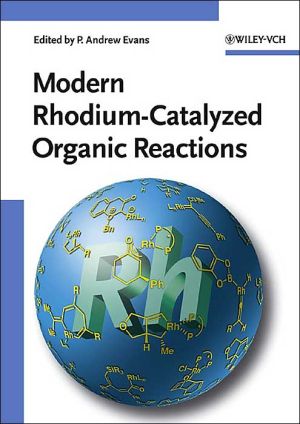

 |

|

Sold Out
Book Categories |
Foreword.
Preface.
List of Contributors.
1 Rhodium-Catalyzed Asymmetric Hydrogenation (Yongxiang Chi, Wenjun Tang, and Xumu Zhang).
1.1 Introduction.
1.2 Chiral Phosphorous Ligands.
1.3 Applications of Chiral Phosphorous Ligands in Rhodium-Catalyzed Asymmetric Hydrogenation.
1.4 Conclusion.
1.5 References.
2 Rhodium-Catalyzed Hydroborations and Related Reactions (John M. Brown).
2.1 Introduction.
2.2 General Advances in Catalytic Hydroboration.
2.3 Advances in Asymmetric Hydroboration.
2.4 Catalytic Diboration of Alkenes.
2.5 Summary and Conclusions.
2.6 References.
3 Rhodium(I)-Catalyzed Asymmetric Addition of Organometallic Reagents to Electron-Deficient Olefins (Kazuhiro Yoshida and Tamio Hayashi).
3.1 Introduction.
3.2 Addition of Organoboron Reagents to α,β-Unsaturated Ketones.
3.3 Mechanism.
3.4 Addition of Organoboron Reagents to Other Electron-Deficient Olefins.
3.5 Addition of Organotin and -silicon Reagents.
3.6 New Aspects of Addition of Organoboron and -titanium Reagents.
3.7 Outlook.
3.8 References.
4 Recent Advances in Rhodium(I)-Catalyzed Asymmetric Olefin Isomerization and Hydroacylation Reactions (Gregory C. Fu).
4.1 Rhodium(I)-Catalyzed Asymmetric Isomerization of Olefins.
4.2 Rhodium(I)-Catalyzed Asymmetric Hydroacylation of Olefins and Alkynes with Aldehydes.
4.3 References.
5 Stereoselective Rhodium(I)-Catalyzed Hydroformylation and Silylformylation Reactions and their Application to Organic Synthesis (James L. Leighton).
5.1 Introduction.
5.2 Hydroformylation.
5.3 Silylformylation.
5.4 Conclusion.
5.5 References.
6 Carbon–Carbon Bond–Forming Reactions Starting from Rh–H or Rh–Si Species (Isamu Matsuda).
6.1 Introduction.
6.2 Background.
6.3 Design of Reactions Starting from Insertion into a Rh–H Bond.
6.4 Design of Reactions Starting from Insertion into a Rh–Si Bond.
6.5 Conclusion.
6.6 References.
7 Rhodium(I)-Catalyzed Cycloisomerization and Cyclotrimerization Reactions (Masaki Fujiwara and Iwao Ojima).
7.1 Introduction.
7.2 Carbocyclization.
7.3 Cascade Carbocyclization.
7.4 Carbonylative Carbocyclization.
7.5 Conclusion.
7.6 References.
8 The Rhodium(I)-Catalyzed Alder-Ene Reaction (Kay M. Brummond and Jamie M. McCabe).
8.1 Introduction.
8.2 Diene Alder-Ene Reactions.
8.3 Enyne Alder-Ene Reactions.
8.4 Allenyne Alder-Ene Reactions.
8.5 Kinetic Resolution.
8.6 Other Rhodium-Catalyzed Ene-Type Reactions.
8.7 Conclusion.
8.8 References.
9 Rhodium-Catalyzed Nucleophilic Ring Cleaving Reactions of Allylic Ethers and Amines (Keith Fagnou).
9.1 Introduction.
9.2 Seminal Work.
9.3 Asymmetric Reactions with Oxabicyclic Alkenes.
9.4 Azabicyclic Alkenes.
9.5 Properties of the PPF-PtBu2 Ligand.
9.6 Mechanistic Working Model.
9.7 Vinyl Epoxides.
9.8 Conclusion.
9.9 References.
10 Rhodium(I)-Catalyzed Allylic Substitution Reactions and their Applications to Target Directed Synthesis (David K. Leahy and P. Andrew Evans).
10.1 Introduction.
10.2 Regioselective Rhodium-Catalyzed Allylic Alkylation.
10.3 Enantiospecific Rhodium-Catalyzed Allylic Alkylation.
10.4 Enantioselective Rhodium-Catalyzed Allylic Alkylations.
10.5 Conclusion.
10.6 References.
11 Rhodium(I)-Catalyzed [2+2+1] and [4+1] Carbocyclization Reactions (Nakcheol Jeong).
11.1 General Introduction to Rhodium-Mediated Carbocyclizations.
11.2 [2+2+1] Carbocyclization.
11.3 [4+1] Carbocyclization.
11.4 Conclusion.
11.5 References.
12 Rhodium(I)-Catalyzed [4+2] and [4+2+2] Carbocyclizations (John E. Robinson).
12.1 Introduction.
12.2 Rhodium(I)-Catalyzed [4+2] Carbocyclization Reactions.
12.3 Rhodium(I)-Catalyzed [4+2+2] Carbocyclization Reactions.
12.4 References.
13 Rhodium(I)-Catalyzed [5+2], [6+2], and [5+2+1] Cycloadditions: New Reactions for Organic Synthesis (Paul A. Wender, Gabriel G. Gamber, and Travis J. Williams).
13.1 Introduction.
13.2 Cycloaddition Approaches to Seven-Membered Rings.
13.3 Design of a Transition Metal-Catalyzed [5+2] Cycloaddition of Vinylcyclopropanes and Π-Systems.
13.4 Intramolecular [5+2] Cycloadditions of VCPs.
13.5 Intermolecular [5+2] Cycloadditions of VCPs and Alkynes.
13.6 Cycloaddition Approaches for Eight-Membered Ring Synthesis.
13.7 Design and Development of [6+2] Cycloadditions of Vinylcyclobutanones.
13.8 Design and Development of Multi-component [5+2+1] Cycloadditions of VCPs, Alkynes, and CO.
13.9 Conclusion.
13.10 References.
14 Rhodium(II)-Stabilized Carbenoids Containing Both Donor and Acceptor Substituents (Huw M.L. Davies and Abbas M. Walji).
14.1 Introduction.
14.2 Cyclopropanation.
14.3 [3+4] Cycloaddition of Vinyl Carbenoids.
14.4 [3+2] Cycloaddition of Vinyl Carbenoids.
14.5 Ylide Transformations.
14.6 Si–H Insertion.
14.7 C–H Activation by Carbenoid-Induced C–H Insertion.
14.8 References.
15 Chiral Dirhodium(II) Carboxamidates for Asymmetric Cyclopropanation and Carbon–Hydrogen Insertion Reactions (Michael P. Doyle).
15.1 Introduction.
15.2 Catalytic Asymmetric Cyclopropanation and Cyclopropenation.
15.3 Catalytic Asymmetric Carbon–Hydrogen Insertion.
15.4 Summary.
15.5 References.
16 Cyclopentane Construction by Rhodium(II)-Mediated Intramolecular C–H Insertion (Douglass F. Taber and Pramod V. Joshi).
16.1 Introduction.
16.2 Background: Cyclization versus Elimination.
16.3 Beginnings of a Computational Approach.
16.4 Comparing and Contrasting Rhodium Catalysts: Four Dimensions of Reactivity.
16.5 Design of an Enantioselective Catalyst.
16.6 Conclusion.
16.7 References.
17 Rhodium(II)-Catalyzed Oxidative Amination (Christine G. Espino and Justin Du Bois).
17.1 Introduction.
17.2 Background.
17.3 Intermolecular C–H Amination with Rhodium(II) Catalysts.
17.4 Intermolecular C–H Amination with Other Metals.
17.5 Intramolecular C–H Amination with Rhodium(II) Catalysts.
17.6 Rhodium(II)-Catalyzed Olefin Aziridination.
17.7 Enantioselective C–H Insertion with Sulfamate Esters.
17.8 Mechanistic Investigations.
17.9 Summary and Outlook for Rhodium(II)-Catalyzed Nitrene Transfer.
17.10 Rhodium(II)-Catalyzed Olefin Diamination.
17.11 Applications of C–H Amination in Synthesis.
17.12 Conclusion.
17.13 References.
18 Rearrangement Processes of Oxonium and Ammonium Ylides Formed by Rhodium(II)-Catalyzed Carbene Transfer (Frederick G. West).
18.1 Introduction.
18.2 Oxonium Ylides.
18.3 Ammonium Ylides.
18.4 Conclusion.
18.5 References.
19 Rhodium(II)-Catalyzed 1,3-Dipolar Cycloaddition Reactions (Ruben M. Savizky and David J. Austin)
19.1 Rhodium(II) in 1,3-Dipole Formation.
19.2 Chemical Aspects of Rhodium-Mediated 1,3-Dipolar Cycloaddition.
19.3 Applications of Rhodium(II)-Mediated 1,3-Dipolar Cycloaddition.
19.4 Conclusion.
19.5 References.
Subject Index.
Login|Complaints|Blog|Games|Digital Media|Souls|Obituary|Contact Us|FAQ
CAN'T FIND WHAT YOU'RE LOOKING FOR? CLICK HERE!!! X
 You must be logged in to add to WishlistX
 This item is in your Wish ListX
 This item is in your CollectionModern Rhodium-Catalyzed Organic Reactions
X
 This Item is in Your InventoryModern Rhodium-Catalyzed Organic Reactions
X
 You must be logged in to review the productsX
 X
 X

Add Modern Rhodium-Catalyzed Organic Reactions, Rhodium has proven to be an extremely useful metal due to its ability to catalyze an array of synthetic transformations, with quite often-unique selectivity. Hydrogenation, C-H activation, allylic substitution, and numerous other reactions are catalyzed b, Modern Rhodium-Catalyzed Organic Reactions to the inventory that you are selling on WonderClubX
 X

Add Modern Rhodium-Catalyzed Organic Reactions, Rhodium has proven to be an extremely useful metal due to its ability to catalyze an array of synthetic transformations, with quite often-unique selectivity. Hydrogenation, C-H activation, allylic substitution, and numerous other reactions are catalyzed b, Modern Rhodium-Catalyzed Organic Reactions to your collection on WonderClub |